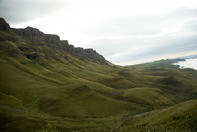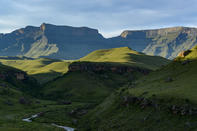Portuguese Reports
Even before the Dutch settled at the Cape, the Drakensberg mountains had been identified by other explorers. In 1593 the Portuguese ship Santo Alberto was bound for home from Cochin, with a rich cargo.

It was wrecked on the Wild Coast and some 300 survivors set off on foot for Lourenco Marques (Maputo). It was January and the many swollen rivers forced them to take a inland route north.
In May they were around the lower Lotheni valley where they reported seeing towering above them to the west, a great range of snow-covered hills. To the south of Giant's Cup/Hodgson’s Peaks, about midway between Sani Pass and Bushman's Nek, a horn-shaped pinnacle (The Rhino) stands free of the main Escarpment.
Rugged Mountains

Back in the day, in the Mzimkhulu area, a formation - 'a remarkable mountain' with a singularly indented outline - was named Giant's Cup by explorer Captain AF Gardiner. He was an ex-navy officer who took zealously to mission work after his wife died. He was instrumental in founding Durban by establishing a mission station at Berea (so-called because according to the Bible 'Berea had noble men') above Port Natal.
From there he set off to find a wagon route over the Drakensberg. In 1835, with Dick King in his party, he investigated all the main valleys from Sani to Bushman's Nek but eventually abandoned the high ground and made for Port St Johns. Along the way he was 'quite startled at the appearance of a rugged mountain, which I have named Giant's Castle' because of its resemblance to Edinburgh Castle. Somehow that name got transferred to a higher peak way to the north, and Gardiner's 'Giant's Castle' is now known as ‘Garden Castle’.
By David Bristow